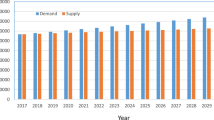Abstract
Scheduling physicians is a complex task. Legal requirements, different levels of qualification, and preferences for different working hours increase the difficulty of determining a solution that simultaneously fulfills all requirements. Unplanned absences, e.g., due to illness, additionally drive the complexity. In this study, we discuss an approach to deal with the following trade-off. Changes to the existing plan should be kept as small as possible. However, an updated plan should still meet the requirements regarding work regulation, qualifications needed, and physician preferences. We present a mixed-integer linear programming model to create updated duty and workstation rosters simultaneously following absences of scheduled personnel. To enable a comparison with previous sequential approaches, we separate our model into two models for the duty and workstation roster which generate plans sequentially. In a case study, we apply our integrated and sequential models to real-life data from a German university hospital with 133 physicians, 17 duties, and 20 workstations. We consider a planning horizon of 4 weeks and reschedule physicians on each day for three different cost settings for the trade-off between plan quality (in terms of preferences, fairness, coverage and training) and plan stability, resulting in a total of 4201 model runs. We demonstrate that our integrated model can achieve near-optimal results with reasonable computational efforts. In each of these runs our model reschedules physicians within 1–21 s. We run the sequential models on the same data, but for only one cost setting, resulting in 1401 runs. The results indicate that our integrated model manages to respect interdependencies between duty and workstation roster whereas the sequential models will always optimize for the plan which is created first. Overall, results indicate that our integrated model parameters allow managing the trade-off between plan quality goals and plan stability.










Similar content being viewed by others
References
Bai J, Fügener A, Schoenfelder J, Brunner JO (2016) Operations research in intensive care unit management: a literature review. Health Care Manag Sci 1–24. doi:10.1007/s10729-016-9375-1
Bard J, Purnomo H (2005) Hospital-wide reactive scheduling of nurses with preference considerations. IIE Trans 37(7):589–608
Baum R, Bertsimas D, Kallus N (2014) Scheduling, revenue management, and fairness in an academic-hospital radiology division. Acad Radiol 21(10):1322–1330
Bertsimas D, Farias VF, Trichakis N (2011) The price of fairness. Oper Res 59(1):17–31
Bölt U (2015) Statistische Krankenhausdaten: Grund- und Kostendaten der Krankenhäuser. In: Klauber J, Geraedts M, Friedrich J, Wasem J (eds) Krankenhaus-Report 2015, chapter 20. Schattauer GmbH, Hölderlinstraße 3, 70174 Stuttgart, Germany, pp 325–359
Brunner JO, Bard JF, Kolisch R (2009) Flexible shift scheduling of physicians. Health Care Manag Sci 12(3):285–305
Burke EK, De Causmaecker P, Berghe GV, Van Landeghem H (2004) The state of the art of nurse rostering. J Sched 7(6):441–499
Clark A, Moule P, Brodie L, Topping A (2014) The challenge of rescheduling nursing staff: Informing the development of a mathematical model decision tool. Project report, University of the West of England, Bristol
Clark A, Moule P, Topping A, Serpell M (2015) Rescheduling nursing shifts: scoping the challenge and examining the potential of mathematical model based tools. J Nurs Manag 23(4):411–420
Clark AR, Walker H (2011) Nurse rescheduling with shift preferences and minimal disruption. J Appl Oper Res 3(3):148–162
Elomri A, Elthlatiny S, Sidi Mohamed Z (2015) A goal programming model for fairly scheduling medicine residents. Int J Supply Chain Manag 4(2)
Erhard M, Schoenfelder J, Fügener A, Brunner JO (2016) State of the art in physician scheduling in hospitals. Working Paper
Fügener A, Brunner JO, Podtschaske A (2015) Duty and workstation rostering considering preferences and fairness: a case study at a department of anesthesiology. Int J Prod Res 53(24):7465–7487
Gunawan A, Lau CH (2013) Master physician scheduling problem. J Oper Res Soc 64(3):410–425
Kitada M, Morizawa K, Nagasawa H (2010) A heuristic method in nurse rerostering following a sudden absence of nurses. In: Proceedings of the 11th Asia Pacific industrial engineering and management systems conference
Miller RB (1968) Response time in man–computer conversational transactions. In: Proceedings of the December 9–11, 1968, fall joint computer conference, part I, AFIPS ’68 (Fall, part I), New York, NY, USA. ACM, pp 267–277
Moz M, Pato MV (2003) An integer multicommodity flow model applied to the rerostering of nurse schedules. Ann Oper Res 119(1–4):285–301
Moz M, Pato MV (2004) Solving the problem of rerostering nurse schedules with hard constraints: new multicommodity flow models. Ann Oper Res 128(1–4):179–197
Moz M, Pato MV (2007) A genetic algorithm approach to a nurse rerostering problem. Comput Oper Res 34(3):667–691. Special Issue: Logistics of Health Care Management
Petrovic S, Vanden Berghe G (2012) A comparison of two approaches to nurse rostering problems. Ann Oper Res 194(1):365–384
Sherali HD, Ramahi MH, Saifee QJ (2002) Hospital resident scheduling problem. Prod Plann Control 13(2):220–233
Stolletz R, Brunner JO (2012) Fair optimization of fortnightly physician schedules with flexible shifts. Eur J Oper Res 219(3):622–629
Topaloglu S, Ozkarahan I (2011) A constraint programming-based solution approach for medical resident scheduling problems. Comput Oper Res 38(1):246–255
van den Bergh J, Beliën J, Bruecker PD, Demeulemeester E, Boeck LD (2013) Personnel scheduling: a literature review. Eur J Oper Res 226(3):367–385
Author information
Authors and Affiliations
Corresponding author
Appendix
Appendix
Rights and permissions
About this article
Cite this article
Gross, C.N., Fügener, A. & Brunner, J.O. Online rescheduling of physicians in hospitals. Flex Serv Manuf J 30, 296–328 (2018). https://doi.org/10.1007/s10696-016-9274-2
Published:
Issue Date:
DOI: https://doi.org/10.1007/s10696-016-9274-2




